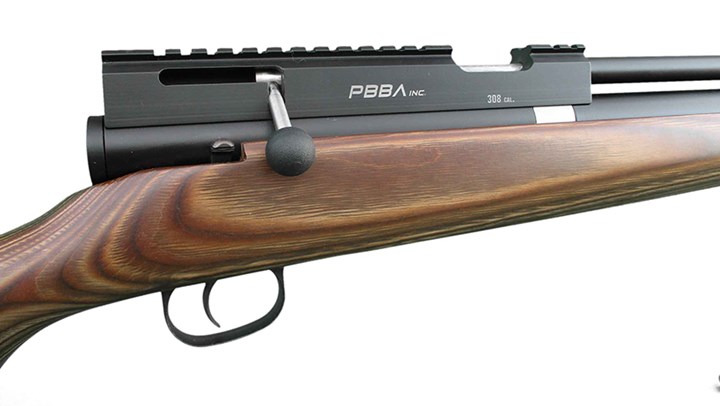
by Brian McCombie - Friday, November 2, 2018

About three years ago, I received an invitation to hunt the exotic axis deer in Texas. I’d be using a big-bore air rifle made by my host, Terry Tate, owner of Professional Big Bore Airguns.
When I mentioned the invite on social media, friends made the same joke: “Hunting deer with a Red Ryder BB Gun! Man, you’re worse than Ralphie in ‘A Christmas Story’! Ha ha!”
The jokes stopped several weeks later when I took a 200-pound axis buck with a single shot from Tate’s pre-charged pneumatic Pro Air Rifle. The 30-caliber air rifle drove a 150-grian bullet through both lungs of the Axis at 60 yards, and the buck didn’t run more than 10 seconds before dropping.
Yes, air rifles have gone well beyond Ralphie and his Christmas dreams. Though they are not on par with firearms for range or power, advanced airgun technology means many of today’s air rifles are still more than powerful enough to take both large- and small-game animals. This past summer, three states affirmed this truth by legalizing the hunting of certain game species with air-powered guns and rifles.
In July, commissioners on the Arkansas Game and Fish Commission (AGFC) voted to legalize certain air rifles for deer hunting. According to an AFGC press release, “To be legal for deer hunting in Arkansas, an air rifle must be at least .40 caliber, produce at least 400 ft. lbs. of energy at the muzzle and be charged from an external tank.”
“This isn’t a CO2-powered pellet rifle, but one that is charged with a scuba-style tank holding 3,500 to 5,500 psi,” explained AGFC's Deer Program Coordinator Ralph Meeker. “The bullet also must be a single, expandable slug, not just a pellet.”
Meanwhile, Gov. Christopher T. Sununu of New Hampshire signed a law that now allows the hunting of small game in that state with air rifles, providing they are at least .22 caliber and capable of producing a minimum of 12 pounds of muzzle energy. The change in New Hampshire law was in part due to the efforts of the newly formed Airgun Sporting Association (ASA). SIG AIR, the airgun division of SIG SAUER, Inc., was a founding member of the ASA, an industry group working to strengthen relationships between state wildlife agencies and representatives of the airgun industry. One key ASA goal: to work toward legalizing airguns for hunting and recreational shooting throughout the United States.
"More states are beginning to recognize that today's advanced airgun technology allows for ethical hunting with airguns, and laws are changing accordingly,” said Joseph Huston, vice president of SIG AIR and member of the ASA Board of Directors. “SIG SAUER and the Airgun Sporting association worked with game officials and legislators here in New Hampshire to amend a bill to allow hunting of small game with air rifles. This change to the hunting laws is welcome news for current airgun enthusiasts and will help open the door to new hunters and shooters over time."
Texas also recently become more air rifle friendly. In August, the Texas Parks and Wildlife Commission (TPWC) approved the hunting of alligators, bighorn sheep, javelina, mule deer, whitetail deer and turkey with pre-charged pneumatic arrow guns and pre-charged pneumatic air guns.
Under the new regulations, “Pre-charged pneumatic air guns must fire a projectile of at least 30-caliber in diameter and at least 150 grains in weight with a minimum muzzle velocity of 800 feet per second or any combination of bullet weight and muzzle velocity that produces muzzle energy of at least 215-foot-pounds of energy,” according to a Texas Parks and Wildlife Department press release.
(My Lone Star axis hunt with an air rifle, by the way, was legal as axis deer fall under the category of exotic species and are assigned different game regulations.)
Squirrels, pheasant, quail and chachalaca also may be hunted with airguns that fire a projectile of at least .177 caliber (4.5 mm) in diameter producing a muzzle velocity of at least 600 feet per second.
Texas did not simply make air rifle and airgun hunting legal. TPWC also took the next step in offering a set of hunting guidelines to reflect the reality of these air-driven arms. The guidelines essentially outline ethical hunting distances and methods with air guns, noting that, much like archery hunting, hunters using air guns and air bows need to recognize the inherent limitations of these devices.
Pre-charged pneumatic air guns and rifles are built with an air reservoir usually located in the stock or forend. That reservoir is pre-charged by an air compressor or a charged air tank (like a scuba tank) to several thousand pounds per square inch of air pressure.
Air Force Air Guns, PBBA, Umarex Airguns and a number of other air gun manufacturers are building pre-charged pneumatic models which can drive a .40- or .50-caliber bullet in excess of 800 feet-per-second. Some are even making pre-charged pneumatic shotguns, including PBBA with a 20-gauge model.
Crosman is among those manufacturers producing air bows, pre-charged pneumatic models that launch full-sized arrows and broadheads. Crosman’s Pioneer Airbow, for example, can propel an arrow at 450 feet per second, faster than most crossbows.
Meanwhile, technical advances to pellet rifles are producing models capable of not only taking down squirrels and other small game, but animals up to the size of coyotes.
Sorry, Ralphie. These aren’t your old-school Red Ryder!
E-mail your comments/questions about this site to:
[email protected]
Proudly supported by The NRA Foundation and Friends of NRA fundraising.
